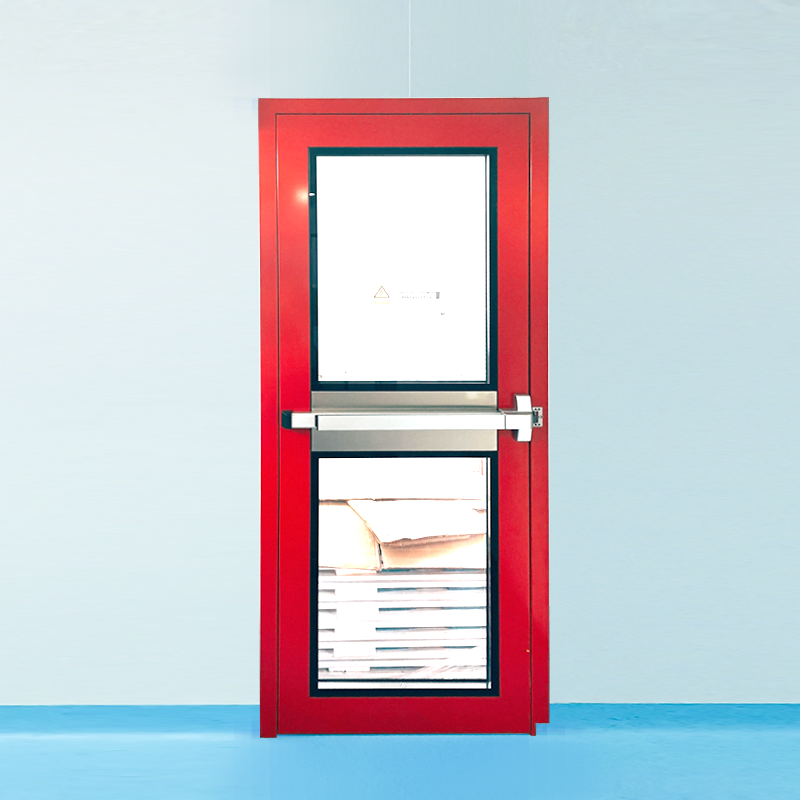When it comes to building safety, one of the most important features in fire prevention is the fireproof door. These unsung heroes of fire protection are designed not only to withstand extreme heat but also to keep flames and smoke contained, thereby providing occupants with valuable time to evacuate and enhancing the effectiveness of fire suppression systems. Among the most reliable materials used for fireproof doors is galvanized steel, which offers an exceptional balance of durability, corrosion resistance, and fire protection. But how exactly do these galvanized steel fireproof doors contribute to the overall fire strategy of a building’s design? Let's take a closer look.
Fire Containment: A Key Element of Safety
One of the primary functions of a fireproof door is containment. When a fire breaks out, it’s crucial to limit its spread as much as possible. Galvanized steel fireproof doors help to create fire-rated zones within a building—separated spaces that slow or prevent the movement of flames and smoke from one area to another. This zoning strategy is especially vital in large commercial buildings, apartment complexes, or industrial facilities where fire could easily move from room to room, endangering more lives and causing widespread destruction.
Galvanized steel, with its enhanced strength and resistance to heat, ensures that the door remains intact and operational during the critical first stages of a fire. In fact, these doors are often tested to withstand temperatures that would melt other materials, ensuring they serve their purpose until emergency responders arrive.
Extended Fire Resistance and Structural Integrity
What sets galvanized steel apart from other materials is its exceptional ability to retain its structural integrity under high heat. Unlike wooden doors, which may warp or ignite, or fiberglass doors that might crack under intense pressure, galvanized steel doors maintain their form and function during a fire. This durability is vital because it allows the door to perform its job—stopping fire and smoke—from the moment it’s needed. In many cases, fireproof doors are rated for anywhere between 30 minutes to 3 hours of fire resistance, depending on the building’s requirements. During this time, they act as the first line of defense, delaying the spread of the fire and providing precious time for both people to evacuate and firefighting systems to work.
Smoke Control: Limiting Dangerous Inhalation
While fire itself is obviously dangerous, smoke inhalation is a leading cause of injury and death in fires. Galvanized steel fireproof doors are often designed with tight seals to prevent smoke from seeping through gaps. By sealing off rooms or sections of the building, these doors help create "smoke barriers" that further isolate the fire’s harmful effects. This containment significantly improves air quality in evacuation routes and common areas, ensuring that people can breathe more easily while making their escape.

Strategic Placement in Fire-Escape Routes
In the design of a building’s fire safety strategy, the placement of fireproof doors is key. Galvanized steel fireproof doors are strategically installed in critical areas such as stairwells, hallways, and fire escape routes. These areas are vital for a safe evacuation, and fireproof doors ensure that these routes stay clear of fire and smoke long enough for people to exit safely. Their placement in doorways, between stairwells, or separating rooms helps to compartmentalize the building during a fire, further slowing the progress of the flames and giving people enough time to move to safety.
Fire Safety Regulations and Building Codes
Building codes and fire safety regulations require the installation of fire-rated doors in certain areas, particularly in high-rise buildings, industrial facilities, and places with large groups of people, like schools or hospitals. Galvanized steel fireproof doors are often chosen to meet these regulations due to their ability to meet stringent fire-resistance standards. These doors are rigorously tested under fire safety protocols, ensuring that they not only comply with local laws but also offer peace of mind to building occupants.
Sustainability and Long-Term Benefits
In addition to their fire-resistant properties, galvanized steel doors are highly durable and resistant to corrosion, which means they last longer with minimal maintenance. This makes them an economically sensible choice for building owners who want to avoid frequent replacements or repairs. Their long lifespan ensures that the fire strategy remains intact for many years, even in environments that might otherwise cause wear and tear on other materials.
An Integrated Fire Protection Solution
In a building’s fire safety strategy, galvanized steel fireproof doors are not just isolated components; they are part of an integrated system. They work in conjunction with other fire protection elements like sprinklers, fire alarms, and emergency lighting. By containing fires and allowing other systems to function optimally, these doors play a vital role in a holistic approach to building safety. They provide the time necessary for fire suppression systems to work, and in some cases, they even help prevent sprinklers from activating prematurely by containing heat and smoke in designated areas.

 English
English русский
русский Español
Español





